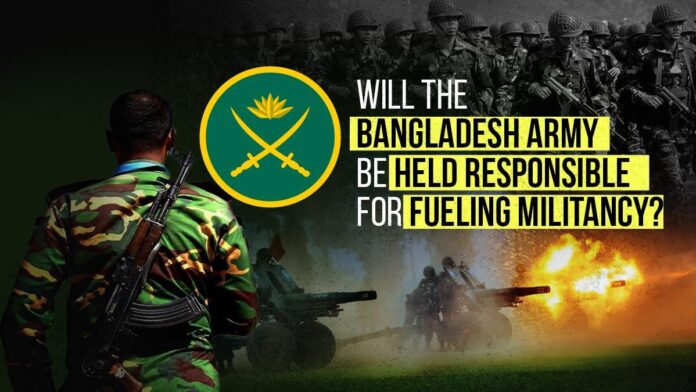Bangladesh is staring down the barrel of a dangerous question—one that few dare to ask out loud but everyone whispers in private: Is the resurgence of Islamist militancy in Bangladesh a coordinated reawakening, or has it been deliberately allowed—perhaps even aided—by the very institutions sworn to protect the republic?
The recent chain of events paints a chilling picture. After more than a decade in the shadows, the banned jihadist group Hizb ut-Tahrir has reemerged with brazen confidence. They are no longer hiding behind encrypted chats or underground cells. They are leafleting in public, organizing rallies at Parliament, holding press conferences at the Dhaka Press Club, and even claiming symbolic victories like tearing down the ‘Deep Swearing’ sculpture honoring victims of the Holey Artisan attack. They didn’t just deface it—they proudly hoisted their banner over it, announcing their presence like a victorious army on conquered ground.
Rising influence of Hizb ut Tahrir in Bangladesh
But this isn’t just about a few fringe radicals. The rot goes deeper.
Shockingly, one of the original three founders of Hizb ut-Tahrir in Bangladesh, Nasimul Ghani, now holds one of the most powerful bureaucratic positions in the country—as Senior Secretary at the Ministry of Home Affairs. This isn’t some low-level desk job—this is the top of the ladder. A man once tied to extremist organizing now sits at the helm of the nation’s security command.
Nasimul, Senior Secretary at Home Ministry, Tied to Hizb ut-Tahrir’s Origins
What kind of system allows a known jihadist ideologue to rise to the top of the ministry meant to fight terrorism?
Also, don’t forget about Mohammad Ejaz—a man who was arrested twice for his direct involvement with Hizb ut-Tahrir since 2002. He is also a known affiliate of the notorious Choton Gang. Today, this same individual has secured a top position within the government itself, as the Administrator of Dhaka North City Corporation.
How does a man with such a record of extremism and gang affiliation rise to public office? Who paves the way?
There is only one institution in Bangladesh with the power to greenlight, protect, or silence such a move: the Bangladesh Army.
And with that name, several explosive questions arise: Has the Bangladesh military been complicit—directly or indirectly—in fueling the return of militancy for political control? Has extremism become a silent weapon in the Army’s toolkit to manipulate unrest, suppress democratic opposition, and maintain unchecked power during an unelected interim regime?
These aren’t just questions of politics anymore. They are questions of national survival.
Hizb ut-Tahrir: How a Banned Group Is Re-Emerging in Politics
In 2009, Hizb ut-Tahrir was officially banned in Bangladesh for promoting radical Islamist ideology and plotting to overthrow the state. Their rhetoric, deeply anti-democratic and pro-caliphate, earned them a place among the country’s most dangerous extremist threats. For years, they operated underground—until now.
In recent months, Hizb ut-Tahrir has re-emerged with unprecedented boldness. No longer hiding in shadows, they are staging rallies near Parliament, issuing public statements, and making political declarations once considered treasonous. The group’s media coordinator Imtiaz Selim even confirmed their involvement in the so-called “July Movement”—a grassroots protest wave that borrowed not only strategy but also structure from Hizb ut-Tahrir, including its signature use of “coordinators” instead of conventional leadership roles.
Even more audacious was their claim of responsibility for dismantling over 1,700 sculptures across the country, including the “Dipto Shopoth” monument at Holey Artisan, which commemorates the victims of the 2016 terrorist attack. By replacing the memorial with their own banner, the group sent a disturbing signal: They’re back—and unafraid.
Vow of Defiance’: Hizb ut-Tahrir Posters Appear at Holey Artisan Attack Site
The question isn’t whether Hizb ut-Tahrir is back in action. The question is: Who allowed them back into the public space so brazenly? And why is their re-entry coinciding with the rise of unelected control under the so-called interim government?
The Army’s Silent Green Light?
The resurgence of Hizb ut-Tahrir isn’t happening in a vacuum. It’s unfolding under the nose—and arguably under the watchful protection—of the Bangladesh military. Ever since the interim regime came into power, backed by unelected actors and opaque institutions, questions have mounted about the role of the armed forces in shaping this new political reality.
Even police investigations into high-profile political violence have become theater, offering just enough noise to appear concerned while avoiding any confrontation with the true perpetrators, many of whom, critics suggest, enjoy untouchable status under military patronage.
If the military isn’t directly orchestrating these developments, it is at least permitting them with strategic silence- a silence that increasingly looks like approval.
Is the Army, under Interim Rule, Using Extremism as a Strategic Tool to Crush Civil Opposition?
In a country where political dissent is met with rubber bullets and opposition leaders are dragged into courtrooms, the quiet release of Hizb ut-Tahrir’s chief—after nearly 14 years behind bars, raises a disturbing question: why now?
This is the same man whose organization was banned for advocating the overthrow of the democratic state and the imposition of a global caliphate. Yet, under the current army-backed interim administration, his release passed with no outcry, no explanation, and no accountability.
While peaceful activists are jailed, surveillance intensifies, and opposition parties are fractured, a notoriously radical figure is set free. Is this incompetence—or intention?
There’s a growing suspicion that the state is no longer just tolerating extremism, but strategically unleashing it. Not to fight a foreign enemy, but to fracture domestic resistance. When extremists are emboldened and democratic voices are suppressed, who is truly running the show—and to what end?
The line between military control and militant complicity is starting to blur. Deliberately.
Will the Army Be Held Responsible? Or Will It Hide Behind the Uniform Again?
Let’s stop pretending. The Bangladesh Army is not a passive observer—it is a central actor in a dangerous game that now threatens the soul of the republic. When banned militant leaders walk free after 14 years under an “interim” government backed by the uniform, when student radicals infiltrate campuses unchecked, and when civil dissent is crushed while extremists flourish—who benefits? Who protects them?
Will the Army be held responsible for allowing militants to slip into state machinery, for promoting them, protecting them, and using them as tools against democratic opposition? Or will it do what it always does—wrap itself in the flag, silence criticism, and claim immunity in the name of “national interest”?
This isn’t national interest. This is strategic extremism—and it’s a betrayal of every citizen who still believes in a secular, safe, and sovereign Bangladesh.
If the Army continues to collude with radicals while smashing dissent, it is not defending the nation. It is destroying it from within.
And the people have every right to ask:
Will the Army finally be held accountable? Or will it keep hiding behind its guns and its lies?





